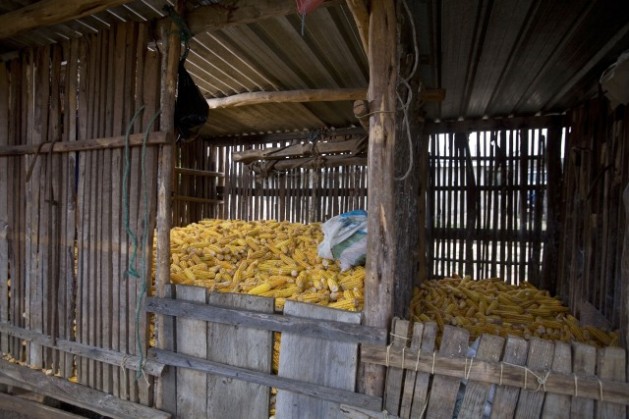Thursday, April 25, 2024
News and Views from the Global South
MEXICO: Saving Native Seeds to Protect Food Heritage

Corn is among the native crops being saved at seed banks in Mexico. Credit: Mauricio Ramos/IPS
- When Guadalupe Ortiz planted gardens in Mexico, she was struck by the importance of saving and preserving the seeds, and decided to do something about the problem of seed supply.
Ortiz founded Canasta de Semillas (Basket of Seeds) in 2002 as a project committed to recovering, investigating, producing, gathering and distributing seeds of native varieties of vegetables. Initially it was funded by the government and the Fundación Merced, a charitable organisation supporting Mexican NGOs.
“We need to reclaim our seeds in order to ensure food security and face the challenges of climate change and the emergence of new pests,” Ortiz told IPS.
Canasta de Semillas is working to create five regional seed reserves, which will distribute seeds to seven community seed banks. The seed bank in Amecameca, a small town 58 km from the Mexican capital, was launched in 2008 on an area of three hectares, and includes an ethnobotanical museum and a library that is under construction.
Ethnobotany is the scientific study of the relationship between people and plants: how and why people use and conceptualise plants in their local environments.
Saving seeds, preserving and exchanging them are ancestral practices in Mexican family farming. But now they have taken on a scientific facet, with the measurement of seed quality and of the capacity to adapt to new climate conditions.
“These seeds have resisted all the changes that have taken place. We distribute seed to the community banks, and nearly all of it has been loaned out” to farmers, who will replace it when they harvest their crops, Alicia Sarmiento, head of the Integrated Rural Development Project (PRODERI) in Vicente Guerrero, told IPS.
PRODERI was launched in 1990 in the southern state of Tlaxcala, and is one of 14 organisations that make up the Programme for Exchange, Dialogue and Advice for Sustainable Agriculture and Food Sovereignty (PIDAASSA). In November, PIDAASSA launched a national campaign with the slogan “For the right to life, save our native seeds! Defend Mexico’s food heritage!”
Meanwhile PRODERI in Vicente Guerrero had a stock in 2010 of two tonnes of seeds, mostly maize, from which every family was given 40 or 50 kilos containing between 10 and 12 varieties.
The campaign aims to highlight the importance of the sustainable agriculture carried out by peasant farmers and indigenous people for production of sufficient, nutritional food, as well as for overcoming the food crisis, conserving and improving natural resources and developing resilience to climate change.
This year Mexico will produce 28.5 million tonnes of basic food grains, 8.5 percent less than in 2010, according to the U.N. Food and Agriculture Organisation (FAO). Close to 500,000 hectares of farmland have been affected by severe drought, especially in the north of the country.
According to FAO forecasts, by the end of 2011, Latin America will have imported 28.4 million tonnes of grain, of which 11 million tonnes will have been bought by Mexico.
“We work with native seeds,” Vicenta Méndez, head of the Rural Association for the Collective Interest – Independent and Democratic (ARIC-ID), told IPS. “It is an essential part of our daily life. We promote sustainable agriculture and looking after native seeds in order to improve food production and protect the environment.”
Farmers belonging to ARIC-ID, in the southern state of Chiapas, have saved maize, beans, rice and squash seeds.
“Here we receive seeds, store them, document them and loan them out. The idea is to sow four varieties of each plant, and see which does best,” said Ortiz of Canasta de Semillas. She is the author of the manuals for establishing seed banks, with advice from the state Chapingo Autonomous University, which manages the National Plant Germplasm Bank.
The National Phytogenetic Resources System donated material for Canasta de Semillas’ seed banks, including solar cells and rainwater collection equipment.
Ortiz, who has been supported since 2009 by Ashoka, a global network of social entrepreneurs, planted organic lettuce, strawberries, cucumbers, parsley and medicinal herbs, in a greenhouse and out in the open, on a plot of land surrounded by forests under the snowy summit of Iztaccihuatl, a 5,286-metre volcano.
The seeds are taken from each plant, weighed, placed in containers, and a portion is refrigerated.
Each community seed bank receives 100 to 200 seeds of each of 20 varieties of each plant, and the plan is to open five more seed banks in 2012, in order to establish a network that will make decisions, be self-sufficient in seed production and continue the work of distribution.
“A network of banks can reach out to rural communities very quickly,” said Ortiz.
Some five million people in Mexico depend on small-scale family farms with an average land area of six hectares, which produce 39 percent of total agricultural output, according to FAO.
The national campaign includes creating seed banks managed by local communities, to improve knowledge about, protection of and propagation of the seeds, and organising fairs where campesinos can exchange seeds and swap experiences about their preservation.
“The loans of seed will be recovered, but we don’t yet know how much we will get back. To qualify for a seed loan, one must be a peasant with a small plot of land and no mechanisation,” PRODERI’s Sarmiento said.
Native seeds face the daunting prospect of climate change effects such as heavy rains, lengthy droughts, and new pests, as well as the slow advance of transgenic crops like cotton, wheat, maize and soy.
“We are expanding our seed bank. Every family selects their best seeds for us,” said Méndez, of ARIC-ID.
-
Lino Matheus de Sá Pereira

 Print
Print



